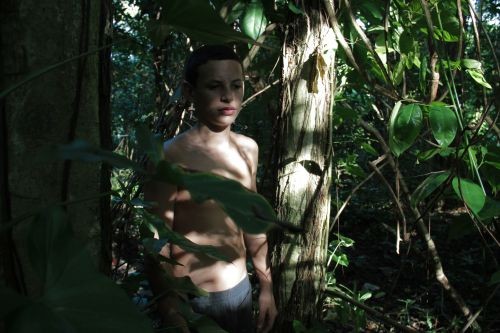The Black Cave
22 Feb - 21 Apr 2013
THE BLACK CAVE
22 February - 21 April 2013
Gasworks presents The Black Cave, the first UK solo exhibition by Beatriz Santiago Muñoz. Consisting of newly commissioned moving image works, the exhibition focuses on the relationship between landscape, history and infrastructure in the artist’s home country of Puerto Rico.
Often documenting her interactions with specific individuals and communities, Santiago's films and videos focus on how social relations are embodied in particular places and gestures. Drawing from anthropology and experimental theatre, the artist develops her work together with the people she portrays, using performance and re-enactment as strategies for self-representation. Her previous works range from an interview with controversial Puerto Rican artist Carlos Irizarry, subsequently interpreted through dance, to an observational documentary about the routine tasks of present-day anarchist communities in San Francisco.
For her exhibition at Gasworks, Santiago has produced two new works that explore the contemporary landscape of Puerto Rico through an historical lens. The video La Cueva Negra (2013) investigates the transformation of a former archaeological site, whereas the 16mm film Farmacopea (2013) looks at how distinctive features of the island’s natural landscape relate to the development of agriculture and tourism.
La Cueva Negra concentrates on the Paso del Indio, an indigenous burial site that was discovered twenty years ago during the construction of a highway. Informed by interviews with the archaeologists and labourers that worked on the excavation, as well as regular interactions with a couple of local boys now living there, this video unravels the material and symbolic history of the site through first-hand accounts, performance and play. In this way, Santiago builds an experimental cosmogony from the layers of trash, the graffiti, the expressway, the karst bedrock, the traces of previous inhabitants’ worldviews, and the impressions of the people living there now.
Farmacopea, on the other hand, looks at how the Puerto Rican landscape has been transformed and de-historicised by tourism and the service industry. The film focuses on particular plant species, such as the Hippomane mancinella (or Manchineel tree), also known as "the little apple of death". This is one of the most toxic plants in the world and indigenous communities are said to have once used its sap to poison their arrow tips. In more recent years however, the Puerto Rican government has sought to eradicate it, greatly transforming the ecology of coastal areas. With Farmacopea, Santiago explores how this desire to render the landscape harmless contributes to the self-image that Puerto Rico wilfully promotes: an idyllic, tropical Caribbean island that somehow stands outside of history and politics.
Using different strategies, the works in The Black Cave recuperate images and understandings of the Puerto Rican landscape that have quite literally been buried beneath a growing infrastructure of transport and tourism.
22 February - 21 April 2013
Gasworks presents The Black Cave, the first UK solo exhibition by Beatriz Santiago Muñoz. Consisting of newly commissioned moving image works, the exhibition focuses on the relationship between landscape, history and infrastructure in the artist’s home country of Puerto Rico.
Often documenting her interactions with specific individuals and communities, Santiago's films and videos focus on how social relations are embodied in particular places and gestures. Drawing from anthropology and experimental theatre, the artist develops her work together with the people she portrays, using performance and re-enactment as strategies for self-representation. Her previous works range from an interview with controversial Puerto Rican artist Carlos Irizarry, subsequently interpreted through dance, to an observational documentary about the routine tasks of present-day anarchist communities in San Francisco.
For her exhibition at Gasworks, Santiago has produced two new works that explore the contemporary landscape of Puerto Rico through an historical lens. The video La Cueva Negra (2013) investigates the transformation of a former archaeological site, whereas the 16mm film Farmacopea (2013) looks at how distinctive features of the island’s natural landscape relate to the development of agriculture and tourism.
La Cueva Negra concentrates on the Paso del Indio, an indigenous burial site that was discovered twenty years ago during the construction of a highway. Informed by interviews with the archaeologists and labourers that worked on the excavation, as well as regular interactions with a couple of local boys now living there, this video unravels the material and symbolic history of the site through first-hand accounts, performance and play. In this way, Santiago builds an experimental cosmogony from the layers of trash, the graffiti, the expressway, the karst bedrock, the traces of previous inhabitants’ worldviews, and the impressions of the people living there now.
Farmacopea, on the other hand, looks at how the Puerto Rican landscape has been transformed and de-historicised by tourism and the service industry. The film focuses on particular plant species, such as the Hippomane mancinella (or Manchineel tree), also known as "the little apple of death". This is one of the most toxic plants in the world and indigenous communities are said to have once used its sap to poison their arrow tips. In more recent years however, the Puerto Rican government has sought to eradicate it, greatly transforming the ecology of coastal areas. With Farmacopea, Santiago explores how this desire to render the landscape harmless contributes to the self-image that Puerto Rico wilfully promotes: an idyllic, tropical Caribbean island that somehow stands outside of history and politics.
Using different strategies, the works in The Black Cave recuperate images and understandings of the Puerto Rican landscape that have quite literally been buried beneath a growing infrastructure of transport and tourism.

